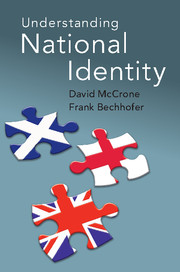Book contents
- Frontmatter
- Contents
- List of tables
- Preface
- Introduction
- 1 Thinking about national identity
- 2 Accessing national identity
- 3 National identity: do people care about it?
- 4 Debatable lands: national identities on the border
- 5 Claiming national identity
- 6 The politics of national identity
- 7 The notional other: ethnicity and national identity
- 8 A manner of speaking: the end of being British?
- 9 Whither national identity?
- Appendix National identity publications
- Bibliography
- Index
4 - Debatable lands: national identities on the border
Published online by Cambridge University Press: 05 April 2015
- Frontmatter
- Contents
- List of tables
- Preface
- Introduction
- 1 Thinking about national identity
- 2 Accessing national identity
- 3 National identity: do people care about it?
- 4 Debatable lands: national identities on the border
- 5 Claiming national identity
- 6 The politics of national identity
- 7 The notional other: ethnicity and national identity
- 8 A manner of speaking: the end of being British?
- 9 Whither national identity?
- Appendix National identity publications
- Bibliography
- Index
Summary
They talk about Scotland and England indeed;
there's Scotland and England and Berwick on Tweed.
Pay a visit to the tourist office in the small town of Berwick-upon-Tweed on the Scottish–English border, and you encounter some curious identity tales. Berwick ‘is at war with Russia’ it has its own language: gadgie (a man); manashee (woman); jougal (dog); it changed hands between Scotland and England some fourteen times; there is also the ditty about Scotland, England and Berwick, and many more. Many small towns have developed their distinctive curiosities to bring in the tourists, so why should Berwick be any different? And why in sociological terms is this interesting? More to the point, what does it tell us about national identities?
Berwick, a town of 11,500 people, sits in the borough of Berwick-upon-Tweed, the most northerly in England, with a population of 26,000. Berwick is further away from London than anywhere else on the mainland, even further from London than Penzance in Cornwall by some fifty miles. In jurisdictional terms Berwick's regional affiliations are to Northumberland, the most northerly county in England, and it lies some 50 miles from Newcastle, Northumberland's largest city which has a population of around 190,000. Berwick is at the far north-easterly end of the Scottish–English border which, far from running from west to east, slopes up roughly north-east from its south-west end, and is further north in terms of latitude than much of southern Scotland.
The current borough of Berwick-upon-Tweed, its English nomenclature, straddles the river Tweed. ‘Berwick’ is the oldest part of Berwick-upon-Tweed and lies within the Elizabethan town walls north of the river. South of the Tweed lie Tweedmouth and Spittal. These latter two parts of the town were originally separate villages but joined with ‘Berwick’ to make up Berwick-upon-Tweed in the nineteenth century.
- Type
- Chapter
- Information
- Understanding National Identity , pp. 68 - 96Publisher: Cambridge University PressPrint publication year: 2015

